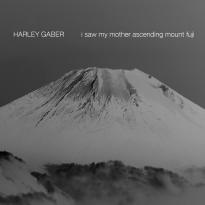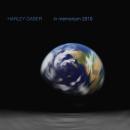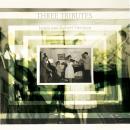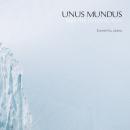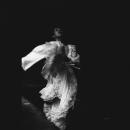I Saw My Mother Ascending Mt. Fuji
I Saw My Mother Ascending Mt. Fuji
San Francisco, CA
| Gaber: I Saw My Mother Ascending Mount FujiiTunes Artist's PageiTunes Album Page | |||
|---|---|---|---|
| Song Title | Time | Price | |
| 1. | I Saw My Mother Ascending Mount Fuji | 1:05:3654 | |
Just over one hour and five minutes, Harley Gaber’s “I Saw My Mother Ascending Mount Fuji” (2009, for Tape and processed Violin and Alto Flute) offers proof of music’s power to transport (the listener) in ways generally associated with film and literature. “Fuji’s” Kaidan-like atmosphere—the Japanese world of ghosts and spirits—unfolds slowly in its process of uncovering and revealing a deeper and different spirit world in what might be termed a spiritual journey: The ascension and transformation of the human spirit into pure energy expressed in the form of both musical and non-musical sounds.
Throughout the 1960s and 1970s Gaber found his own unique compositional language that combined the intensity and extra-musical framing of certain post war, European Modernism with sparser, more obviously spiritual evocations of Eastern aesthetics as made manifest in such diverse expressions as Haiku poetry, Sumi-e painting, and even martial arts forms.
In 1978 he moved from New York City to La Jolla, Ca and stopped making music. Following a two-year hiatus from the arts, he commenced on what was to become a twenty year period of creating an immense body of work in the plastic arts and photography. Much of the work done during that period was informed by his musical instincts and focused, as did much of his later music, on the unity and interrelatedness of things. His predilection for collage work in general reflects and confirms that focus. The years of making art culminated with his largest artistic and personal undertaking in the construction of DIE PLAGE, a photo-collage work of some 5,500 (20 x16 in.) canvases detailing German history in the first half of the 20th Century.
With the completion of DIE PLAGE in the early part of 2002, Gaber turned to writing about the project and to film making, first using images from DIE PLAGE for his films and eventually moving on to other subjects. His return to music began with the creation of soundtracks for all his films. Initially, the soundtracks were (again) in a collaged form using, for the most part, music of others, but also incorporating his own music from old recordings and taped performances. His real return to music composition came in 2008 with his original soundtrack for “Mein Kamps: Akt V” (filmed in Berlin and named after the Berlin bakery chain Kamps). That original soundtrack (existing apart from the film as a strictly musical composition is titled “Berliner Strassen Gesang”) demonstrates a richer, more complex approach to crafting and shaping sound made possible by the use of the computer in composing the work along with the twenty years of rethinking his artistic outlook in general, and his musical thinking in particular.
And now, with “I Saw My Mother Ascending Mount Fuji,” Gaber has returned to music composition. This new work is at once a processing of untimely deaths in his family and a reconsideration of earlier compositions—“Michi” for solo violin (1972) and “Chimyaku” for solo alto flute—which, in their processed and altered form and in conjunction with an entirely new tape part, project a new level of insight into the essential spiritual nature of sound and its physicality; “ . . .both transcendentally abstract and distinctly human,” as the composer puts it. The ascension of Mount Fuji is a meditative journey, a spiritual odyssey perhaps, as real as it is imagined or metaphoric. The composer, however, leaves those distinctions for each listener to decide for him or herself.
Harley Gaber studied with Kenneth Gaburo and Darius Milhaud among others. He died in 2011.
Maverick American composer Harley Gaber (b. 1943) completed I Saw My Mother Ascending Mount Fuji in 2009, but it actually contains genetic splices from the late sixties and early seventies, as it incorporates ”Chimyaku” for alto flute and ”Michi” for violin, as well as inspiration which came to him while mourning the death of his mother in 1991.
Flute and violin have been multi-tracked and processed and massaged into a windy vastness Gaber created through tape recorder manipulation. The hour-long piece now premiered is both harrowing and beautiful. One is doubly stimulated into feeling uplifted and weightless while struggling with the physical reaction of straining against the wind, the snow, the unreliable ground purchase. While the violin regularly jabs the listener out of his reverie – or threatening torpor – with the intermittent pluck or stab of bow on strings, both it and the flute otherwise maintain a peaceful coexistence with the howling gale. Both too rise above the unrelenting blast on unpredictable occasions, either in sweet melody or ominous screech.
"Transcendent" is a word the Romantics freighted with ontological import - that our consciounesses are inextricably linked with our physical world. No surprise that the etymology of the word refers to climbing over and beyond. And transcendence is indeed also the state induced by this singular recording.
- Stephen Fruitman, Sonomu
Alternating between resonant aggressive plucks and bowed tones, the violin's sawing drone hovers in mid-air while background screams repeatedly swoop in like a murder of crows. Like the violin, the flute's high-pitched flutter floats high o'ertop a droning background whose protracted moaning suggests an anguished, Ligeti-esque choir of condemned souls pleading for release from their stricken state. Moments of near-stillness and piercing intensity appear in equal measure but in general the piece perpetuates a mood of disturbed serenity.
"Gaber's mix is exemplary, camouflaging the more obvious canonic procedures of the multitracked violins and placing the flute tones and field recording with remarkable care. The performances are equally superlative: David Gilbert's exquisitely varied vibrato recalls the great shakuhachi master Watazumi Doso, and Cummisky's intonation and bow control are worthy of Irvine Arditti or Charles Curtis. The resulting 65 minute piece is a tour de force of spectral music, a remarkable journey across 40 years of artistic thought and development."
- Dan Warburton, The Wire
"What is striking is how contemporary ... these pieces sound now. The originals are radically sparse and minimal: long notes punctuated by extensive pauses, a high intensity focus on minute shadings of timbre and pitch. The radical sonic edge of these earlier pieces has been smoothed out by an ambient electronic background of hisses and echoes, but the immensely slow pace remains. In fact, by using the electronic part to cover over passages of silence in the original recordings (which were in any case obliterated by tape hiss) Gaber has further slowed that pace: where before there was at least a clear articulation of on and off, sound and silence, now there is an ever-shifting continuum of sound, a promise of surge and development that is never fulfilled. Despite their minimalism, those earlier pieces had a strongly defined structural articulation. In I Saw my Mother Gaber has subsumed even that into the background: what at first sounds like 100 other 21st-century ambient albums is haunted by a more utopian, idealistic radicalism, a memory of something lost or a discovery of something new?"
- Tim Rutherford-Johnson, The Rambler
